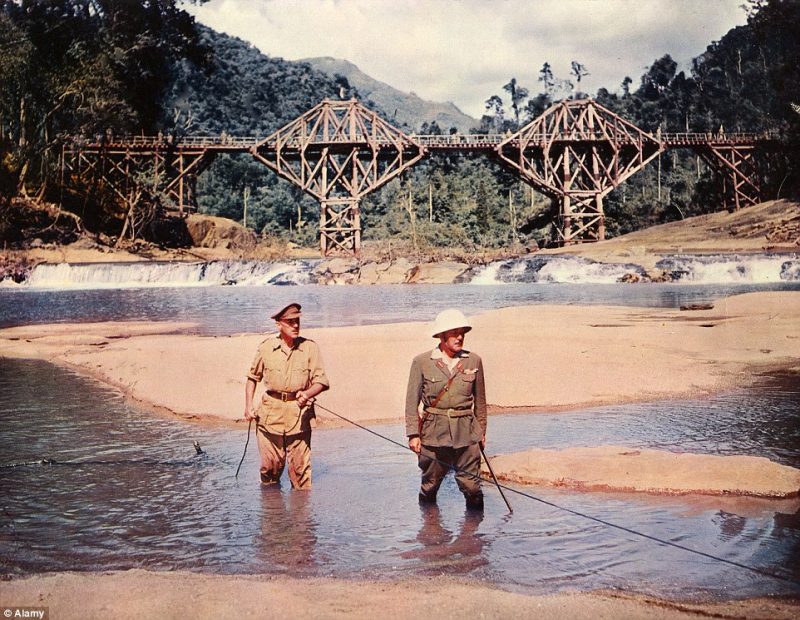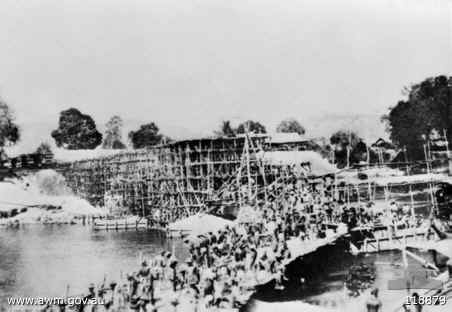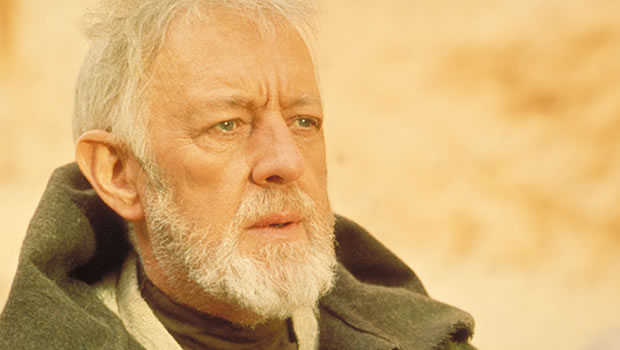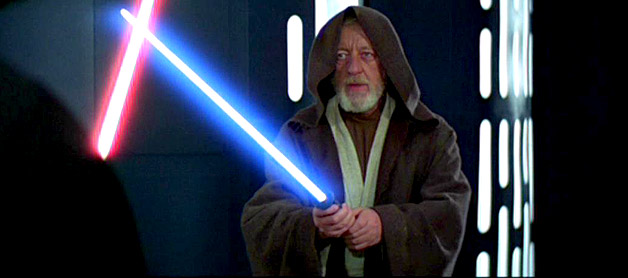During one such voyage in 1944, Guinness’s boat was caught in a violent hurricane off the coast of Italy, and he only narrowly managed to guide the ship into a harbor before it was thrown onto a rocky shoreline and damaged beyond repair. Guinness would later put his wartime experience to use portraying military officers in such films as “The Bridge on the River Kwai” and “Tunes of Glory,” and even played Adolf Hitler in 1973’s “Hitler: The Last Ten Days.”
A lot of the credit for the original Star Wars
being a decent movie must go to Alec Guinness, who plays Obi-Wan Kenobi
and brings a lot of gravitas to explaining the Force and the
complicated backstory about the Clone Wars. But Guinness didn’t think
much of Star Wars when he was filming it — he only took the role after
they doubled his pay, and he still griped afterwards.
Over at Business Insider,
they quote from a couple of Guinness’ letters, as cited in Alec
Guinness: The Official Biography. (Disclaimer: I couldn’t find these
letters in the Google Books edition of the book, but the relevant page
wasn’t included in the preview.) Prior to accepting the role, Guinness
wrote to his friend:
I
have been offered a movie (20th Cent. Fox) which I may accept, if they
come up with proper money. London and N. Africa, starting in mid-March.
Science fiction – which gives me pause – but is to be directed by Paul
[sic] Lucas who did “American Graffiti, which makes me feel I should.
Big part. Fairy-tale rubbish but could be interesting perhaps.
And once he was on set, Guinness was no more impressed, writing to his friend:
...
new rubbish dialogue reaches me every other day on wadges of pink paper
– and none of it makes my character clear or even bearable. I just
think, thankfully, of the lovely bread, which will help me keep going
until next April even if Yahoo collapses in a week … I must off to
studio and work with a dwarf (very sweet – and he has to wash in a
bidet) and your fellow countrymen Mark Hamill and Tennyson (that can’t
be right) Ford. Ellison (? – No!) – well, a rangy, languid young man who
is probably intelligent and amusing. But Oh, God, God, they make me
feel ninety – and treat me as if I was 106. – Oh, Harrison Ford – ever
heard of him?
The mention of “Yahoo” refers to a play based on Gulliver’s Travels that Guinness starred in around that time. I love the idea of Guinness wandering around the Star Wars set calling Harrison Ford “Tennyson.” [Business Insider].
But many of us know him from the classic WWII film The Bridge on the River Kwai.
The
largely fictional film plot is loosely based on the building in 1943 of
one of the railway bridges over the Mae Klong—renamed Khwae Yai in the
1960s—at a place called Tha Ma Kham, five kilometres from the Thai town
of Kanchanaburi.According to the Commonwealth War Graves Commission:
“The notorious Burma-Siam railway, built by Commonwealth, Dutch and American prisoners of war, was a Japanese project driven by the need for improved communications to support the large Japanese army in Burma. During its construction, approximately 13,000 prisoners of war died and were buried along the railway. An estimated 80,000 to 100,000 civilians also died in the course of the project, chiefly forced labour brought from Malaya and the Dutch East Indies, or conscripted in Siam (Thailand) and Burma. Two labour forces, one based in Siam and the other in Burma, worked from opposite ends of the line towards the centre.
Plot
In World War II, British prisoners arrive at a Japanese prison camp in Thailand. The commandant, Colonel Saito (Sessue Hayakawa), informs them that all prisoners, regardless of rank, are to work on the construction of a railway bridge over the River Kwai. The senior British officer, Lieutenant Colonel Nicholson (Alec Guinness), reminds Saito that theGeneva Conventions exempt officers from manual labour.At the following morning’s assembly, Nicholson orders his officers to remain behind when the enlisted men are sent off to work. Saito slaps him across the face with his copy of the conventions and threatens to have them shot, but Nicholson refuses to back down. When Major Clipton (James Donald), the British medical officer, intervenes, Saito leaves the officers standing all day in the intense tropical heat. That evening, the officers are placed in a punishment hut, while Nicholson is locked in an iron box.
Meanwhile, three prisoners attempt to escape. Two are shot dead, but United States Navy Commander Shears (William Holden), gets away, although badly wounded. He stumbles into a village. The villagers help him escape by boat.
Nicholson refuses to compromise. Meanwhile, the prisoners are working as little as possible and sabotaging whatever they can. Should Saito fail to meet his deadline, he would be obliged to commit ritual suicide. Desperate, Saito uses the anniversary of Japan’s victory in the Russo-Japanese War as an excuse to save face and announces a general amnesty, releasing Nicholson and his officers.

The 1957 film was shot in various locations, concentrating in particular on Sri Lanka.
Nicholson
conducts an inspection and is shocked by the poor job being done by his
men. Over the protests of some of his officers, he orders Captain
Reeves (Peter Williams) andMajor Hughes (John Boxer) to design and build
a proper bridge, despite its military value to the Japanese, for the
sake of maintaining his men’s morale. The Japanese engineers had chosen a
poor site, so the original construction is abandoned and a new bridge
is begun downstream.Shears is enjoying his hospital stay in Ceylon, when British Major Warden (Jack Hawkins) asks him to volunteer for a commando mission to destroy the bridge before it’s completed. Shears is appalled at the idea and reveals that he is not an officer at all. He switched uniforms with a dead officer after the sinking of their cruiser, USS Houston (CL-30), as a ploy to get better treatment. Warden already knows this. Faced with the prospect of being charged with impersonating an officer, Shears volunteers.
Meanwhile, Nicholson drives his men hard to complete the bridge on time. For him, its completion will exemplify the ingenuity and hard work of the British Army for generations. When he asks that their Japanese counterparts join in as well, a resigned Saito replies that he has already given the order.
The commandos parachute in, with one man being killed on landing. Later, Warden is wounded in an encounter with a Japanese patrol and has to be carried on a litter. He, Shears, and Canadian Lieutenant Joyce (Geoffrey Horne) reach the river in time with the assistance of Siamese women bearers and their village chief, Khun Yai. Under cover of darkness, Shears and Joyce plant explosives on the bridge towers below the water line.
A train carrying soldiers and important dignitaries is scheduled to be the first to cross the bridge the following day, so Warden waits to destroy both. However, at daybreak the commandos are horrified to see that the water level has dropped, exposing the wire connecting the explosives to the detonator. Making a final inspection, Nicholson spots the wire and brings it to Saito’s attention. As the train is heard approaching, they hurry down to the riverbank to investigate.

February
1943. Allied prisoners of war (POWs) engaged in bridge building at
Tamarkan, fifty five kilometres north of Nong Pladuk (also known as Non
Pladuk) and five kilometres south of Kanchanaburi (Kanburi). The
scaffolding, made from bamboo, is at the site of the eleven span steel
bridge which was completed in April 1943. It, together with a wooden
bridge approximately 100 kilometres downstream, spanned the Mae Klong
river (renamed Kwai Yai river in 1960).
Joyce, manning
the detonator, breaks cover and stabs Saito to death. Aghast, Nicholson
yells for help, while attempting to stop Joyce from reaching the
detonator. When Joyce is shot dead by Japanese fire, Shears swims across
the river, but is fatally wounded as he reaches Nicholson. Recognizing
the dying Shears, Nicholson exclaims, “What have I done?” Warden fires
his mortar, mortally wounding Nicholson. The dazed colonel stumbles
towards the detonator and collapses on the plunger, just in time to blow
up the bridge and send the train hurtling into the river below.
Witnessing the carnage, Clipton shakes his head uttering, “Madness! …
Madness!”


Δεν υπάρχουν σχόλια:
Δημοσίευση σχολίου